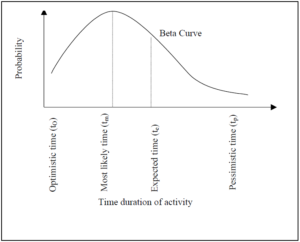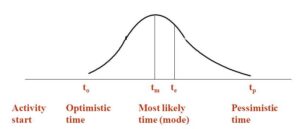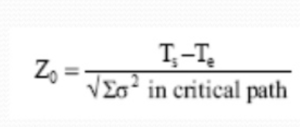OPERATIONS MANAGEMENT
DRAWING THE PERT NETWORK:
In the critical path method, the time estimates are assumed to be known with certainty. In certain projects like research and development, new production introductions, it is difficult to estimate the time of various activities. Hence PERT is used in such projects with a probabilistic method using three time estimates for an activity, rather than single estimate.

-
OPTIMISTIC TIME (to):
Optimistic Time is the shortest time taken to complete the activity. It means that everything goes well and there is more chance of completing the activity within this time.
-
MOST LIKELY TIME (tm):
Most Likely Time is the normal time taken to complete an activity, if the activity were frequently repeated under the same conditions.
-
PESSIMISTIC TIME (tp):
Pessimistic Time is the longest time that an activity would take to complete. It is the worst time estimate that an activity would take if unexpected problems are faced.
Taking all these time estimates into consideration, the expected time of a activity is arrived at. The average or mean (ta) value of the activity duration is given by:
ta = [frac up=”(to + 4tm + tp)” down=”6″]
The probability distribution of the time involved in performing the activity might be characterized by Beta distribution. It is assumed that the distribution is unimodal and the peak will represent the value of tm. PERT assumes that all the job time (to, tp, tm) are independent and are identically distributed. Hence, by Central Limit Theorem of statistics the time of completion has a normal distribution with mean te and standard deviation, S.D = σ.

There is very little chance that the activity can be completed before to and after tp. The point tm is free to move between these two times. Another assumption is that for unimodal distribution, the standard deviation can be estimated roughly as one sixth range, i.e. σ = [frac up=”(tp – to)” down=”6″] and hence the variance = [frac up=”(tp – to)” down=”6″]²
PROBABILITY FOR PROJECT DURATION:
The probability of completing the project within the scheduled time (ts) may be obtained by using the standard normal deviate where te is expected time of project completion.

RELATED VIDEOS:
